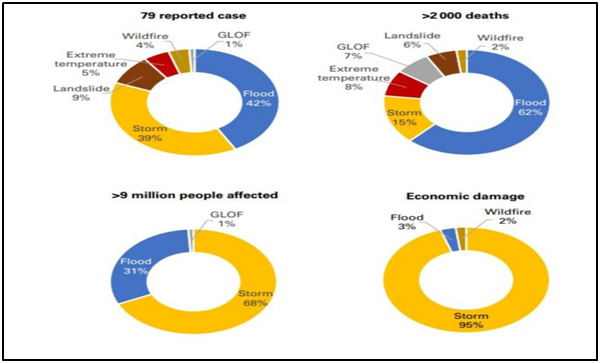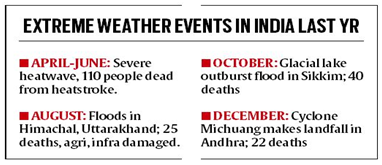Why in News?
According to a World Meteorological Organisation’s (WMO) report (‘State of the Climate in Asia 2023’), Asia faced the most disasters in the world in 2023.
What’s in Today’s Article?
- Key Highlights of the ‘State of the Climate in Asia 2023’ Report:
- What the ‘State of the Climate in Asia 2023’ Report Highlighted About India?
- What Needs to be Done?
Key Highlights of the ‘State of the Climate in Asia 2023’ Report:

- Number of extreme weather events in Asia: 79 events associated with extreme weather, climate and water-related hazards in 2023 affected over 9 million people in the region, directly killing over 2,000 people.
- Compared to 2022, the reported disaster events in the region were lesser by only two in 2023.
- The number of people impacted in 2023 was lower as the 2022 Pakistan floods had alone affected over 30 million people.
- The mean temperature over Asia: In 2023, it was 0.91°C above the 1991–2020 reference period, the second highest on record.
- Many parts of the region experienced extreme heat events in 2023. Japan experienced its hottest summer on record.
- Glaciers in High-Mountain Asia: They have lost significant mass over the past 40 years, at an accelerating rate.
- In 2023, record-breaking high temperatures and drier conditions in the Eastern Himalayas and the Tien Shan (mountain range) exacerbated mass loss.
- The ocean around Asia: Has shown an overall warming trend since the time series began in 1982.
- In 2023, sea-surface temperature anomalies in the north-west Pacific Ocean were the highest on record.
- South-west China suffered from a drought: This was because of the below-normal precipitation levels nearly every month of 2023.
- Floods and storms accounted for 80% of hydrometeorological hazards: For instance, Yemen suffered heavy rainfall and resulting widespread floods.
What the ‘State of the Climate in Asia 2023’ Report Highlighted About India?

- In India, the impacts of extreme weather events were felt strongly as the country experienced severe heat waves, rainfall-induced floods, glacial lake outbursts and tropical cyclones.
- Severe heat waves (in April and June 2023) resulted in about 110 deaths due to heatstroke.
- For example, the Ballia and Deoria districts in Uttar Pradesh saw the deaths of over 100 people, many of them senior citizens with co-morbidities.
- Temperatures were in the 42-43 degrees Celsius range in the region during these heat-related deaths.
- Flood events occurred in India during August 2023 and Himachal Pradesh and Uttarakhand recorded 25 deaths as well as extensive damage to infrastructure and agriculture.
- The Indian government declared a state of emergency in the worst-affected areas, initiating rescue and relief operations.
- The Indian sub-continent experienced six tropical cyclones in 2023 which formed in the North Indian Ocean. The cyclone activity was slightly above the average of 5.4 cyclones.
- Four out of the six cyclones - Mocha, Hamoon, Midhili and Michaung - formed over the Bay of Bengal and two - Biparjoy and Tej - formed over the Arabian Sea.
- A significant glacial lake outburst flood in South Lhonak Lake in Sikkim on October 4 last year, breached the Chungthang dam downstream on the Teesta River and killed over 40 people.
What Needs to be Done?
- Disaster risk reduction in the Asia region is facing an alarming gap in climate projections and tailored products that are needed to inform long-term interventions such as adaptation to and mitigation of climate change and its impacts.
- Currently, less than 50% of WMO Members are providing tailored products, indicating a significant inadequacy in view of the region’s high vulnerability to climate-related disasters.
- By 2030, annual losses in Asia (due to extreme weather events) are expected to be over USD 160 billion, which is close to 0.6% of the region’s GDP, up from 0.1% in the 1970s.
- Therefore, there is an urgent need to advance these efforts and provide more tailored support products to address long-term strategies as well as medium and short-term activities and interventions to effectively mitigate disaster risks.









